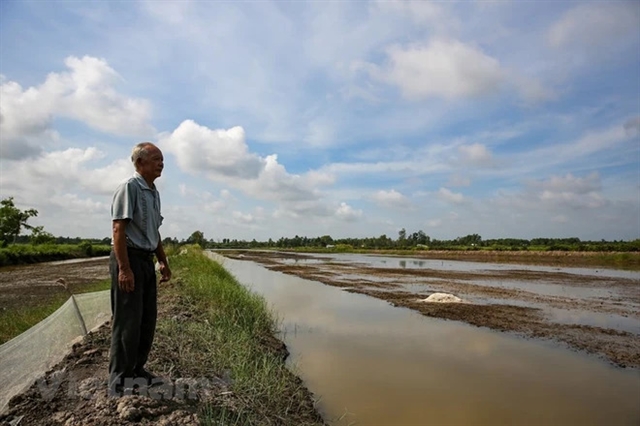 Environment
Environment

 |
| Saline intrusion in the Mekong Delta is projected to deepen in February. — VNA/VNS Photo |
MEKONG DELTA — The Ministry of Natural Resources and Environment (MoNRE) has recommended localities in the Cửu Long (Mekong) Delta to closely monitor saltwater intrusion information and forecast bulletins, which are predicted to peak in February 2024.
According to the agency, the water flow from the Mekong River basin to the Mekong Delta during the dry season of 2024 is continuing to decrease, so salinisation is estimated to intensify in the fields. The deepest intrusion is expected to occur from February 10-14.
Localities in the Mekong Delta, known as Việt Nam's “rice bowl”, need to store fresh water to avoid localised drought.
It is forecast that the total rainfall in the Mekong River basin will be lower than the average for many years by between 10 and 20 per cent in February, according to the representative of the Việt Nam Mekong River Commission under MoNRE.
At the beginning of February, water reservoirs on the Lancang River of China are at about 56 per cent of the total usable capacity, with the Nuozhadu reservoir at about 40 per cent of its water capacity. Reservoirs in the lower Mekong River basin are also at about 61 per cent of their capacity.
The highest water level at the Tân Châu station in An Giang Province in February is predicted to fluctuate with the tide, ranging from 1.1m to 1.7m.
The average daily water flow to the Mekong Delta through the Tân Châu and Châu Đốc stations in February is forecast to continue decreasing from 6,000cu.m to about 3,800cu.m per second. This is lower than the average for many years and the same period in 2023, the commission reported.
Water with a salinity of one per cent would intrude 9-13km deeper than the average for many years in the Hậu, Tiền and Vàm Cỏ Tây rivers and deeper than the saline intrusion in the same period in February 2023 from 5-6km.
Saltwater intrusion with a salinity rate of four grammes per litre is expected to enter 8-11km deeper than the average in many years and 4-7km deeper than the same period in 2023.
The forecast predicts the deepest saltwater intrusion including both one and four per cent in February 2024.
According to the Việt Nam Mekong River Commission, due to the increasingly scarce water source in the Mekong Delta during the dry season, localities in the region need to plan for rotational water withdrawal from rivers to avoid localiaed shortages, preventing the possibility of deeper salinity.
As warned by the National Centre for Hydro-Meteorological Forecasting, the provinces frequently affected by saltwater intrusion in the Mekong Delta during the dry season include Long An, Tiền Giang, Trà Vinh, Bến Tre, Bạc Liêu, Sóc Trăng, Kiên Giang and Hậu Giang.
Deputy director of the National Centre for Hydro-Meteorological Forecasting, Hoàng Phúc Lâm, said that saline intrusion during the dry season of 2023-2024 in the Mekong Delta is expected to be higher than the average of many years. However, it is likely not to be as severe as in 2015-2016 or 2019-2020.
The peak of salinisation at the Mekong River estuary is expected to concentrate in February and March, specifically around February 8-13, February 22-27, and March 18-25.
For the Vàm Cỏ and Cái Lớn rivers, the highest saline intrusion is projected to occur in March and April, with peak periods around March 8-13, March 22-27, April 7-12, and April 21-26.
Lâm said that the agency will collaborate with regional meteorological stations in the southern region to issue saline intrusion forecasts in the Mekong Delta.
Based on the local saltwater intrusion situation, provincial meteorological stations will release forecast bulletins on saltwater intrusion on the 10th, 20th, and end of each month.
Additionally, to support local disaster prevention efforts, some provincial hydrometeorological stations issued an additional bulletin in the middle of the week. — VNS




